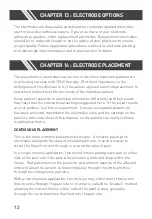
12
CHAPTER 13 : ELECTRODE OPTIONS
CHAPTER 14 : ELECTRODE PLACEMENT
The electrodes are disposable and should be routinely replaced when they
start to lose their adhesive nature. If you are unsure of your electrode
adhesive properties, order replacement electrodes. Replacement electrodes
should be re-ordered through or on the advice of your physician to ensure
proper quality. Follow application procedures outlined in electrode packing,
to maintain optimal stimulation and to prevent skin irritation.
The placement of electrodes can be one of the most important parameters
in achieving success with TENS therapy. Of utmost importance is the
willingness of the clinician to try the various styles of electrode placement to
find which method best fits the needs of the individual patient.
Every patient responds to electrical stimulation differently and their needs
may vary from the conventional settings suggested here. If the initial results
are not positive, feel free to experiment. Once an acceptable placement
has been achieved, mark down the electrodes sites and the settings on the
patient’s reference sheet of this manual, so the patient can easily continue
treatment at home.
CONTIGUOUS PLACEMENT
This is the most common placement technique. It involves placing the
electrodes alongside the area of localized pain site, in such a way as to
direct the flow of current through or around the area of pain.
In a single channel application, this would involve placing each pad on either
side of the pain site if the pain is localized on a limb and deep within the
tissue. Pad placement on the posterior and anterior aspects of the affected
limb will allow the current to flow completely through the limb and thus
through the endogenous pain site.
With a two channels application, the clinician may either direct the current
flow to cross through the pain site or, in what is called the “bracket” method
allowing the current flow on either side of the painful area, generally
through the nerve branches that feed into the pain site.






































